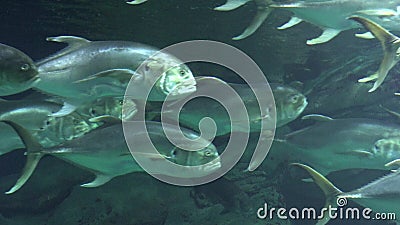
A Fourspot Butterflyfish & Endemic Potters Angelfish found only in Hawaii, also very desired for aquariums. And if you must have a saltwater aquarium please purchase only captive bred fish. Our oceans are under attack from many sources and ending tropical fish collecting for aquariums is one important way that we all can help. Tropical fish living on coral reefs around the world serve an important purpose and without them the reefs themselves will die. Yellow Tangs can live over 41 years on a coral reef (it has been established) while if you read many aquarium blogs you will find endless comments of yellow tangs dying in the first couple of days or weeks, or on and on. 99 percent of fish captured for aquariums die within one year. While fish are treated like cut flowers to beautify ones home, then thrown away when dead (or flushed while still alive), only to be easily replaced with another visit to the aquarium store. Meanwhile, on my home island of Hawaii we are fighting for the very life of our coral reefs. While in actuality they have shut their eyes to the destruction of the marine environment that is caused directly by their selfishness to have "fake" nature for their own personal pleasure. "We're not greedy many aquarists," will say, "It's our love of marine life and the ocean that drives our interest in keeping saltwater aquariums and our insatiable desire to view and care for the beautiful fish within our homes". Their flesh is a gelatinous mass with a slightly lower density than water. They are found in deep waters along the south coasts of Australia, Tasmania and New Zealand. After all a rare fish is worth more money in an industry fueled by greed. The blobfish, a deep-sea creature, belongs to the Psychrolutidae family. I later found out, after doing some research and seeing it again and again with my own eyes that damage to coral reefs is normal and that taking rare fish is normal. Why? Besides the fact that his boat was anchored on a coral reef causing immense damage, he was taking fish in an area where seven days ago I caught my first glance of a very rare fish. My first meeting with an aquarium collector led me to protest the practice. Secondly, I live in Hawaii so I have some knowledge of how 98 percent of tropical fish for aquariums are collected from the wild. Mola A mola, or sunfish, off the coast of Maine.Firstly, I am by no means an expert, but I am a devoted ocean lover. It’s found in the deep waters of the North Atlantic.
#UGLY FISH MARINE SUPPLY SKIN#
It’s one of the most-studied species, too, with its mucous and skin offering biologists and scientists numerous opportunities. The hagfish looks more like a giant earthworm, to be honest, although technically it’s a fish. The skin also contains sacs of slime or mucous, which is venomous, and may be able to aid with respiration when the fish is buried in mud.
#UGLY FISH MARINE SUPPLY FULL#
It contains most of their blood, thus the flabby appearance like a plastic grocery bag full of water. Their skin may be pink, blue-gray or some other color, depending on species and location. They have long bodies with skin that looks like a rumpled sock, or maybe a hairless cat.


Their skull isn’t hard bone, but instead is cartilage, as is their vertebrae. READ NEXT: Tips for Catching Trophy Flathead Catfish FlounderĪsk a child to draw their wildest imaginary fish and chances are good they might sketch something like the hagfish. Despite the ugly features, flatheads are tremendous hunters thanks to a keen sense of taste and detection of vibrations emitted by other species. A fan of live forage such as crayfish, sunfish, and larger gizzard shad. Flatheads have tiny eyes for their size, along with a wide mouth. Its body is long and flat, unlike the stocky blue cat that sports a bulging belly. It’s also know as a mudcat and shovelhead. Depending on the location and age, it may have more of a yellowish or dark hue. Some anglers call it a “yellow cat,” which isn’t an official species but is common enough that catmen will know what you’re talking about. It typically has an olive-colored body with yellowish-white belly. Neither the blue nor channel cat are lookers, the flathead, though, makes you look twice. Of all the commonly known catfish species, the flathead surely takes the prize of Top Ugly. Flathead Catfish A big Saginaw River cat.


 0 kommentar(er)
0 kommentar(er)
